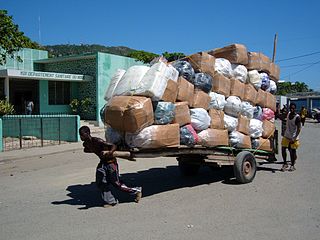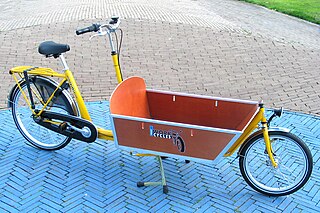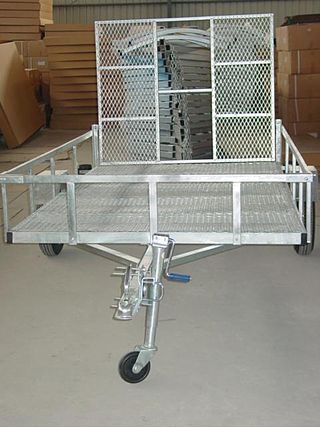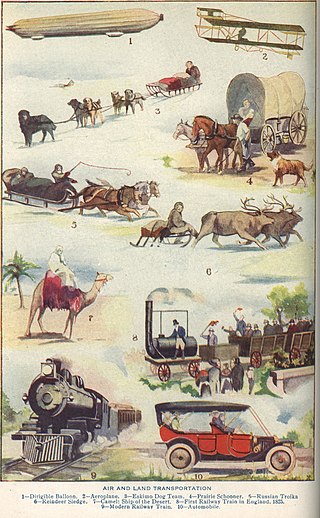
A pickup truck or pickup is a light-duty truck that has an enclosed cabin, and a back end made up of a cargo bed that is enclosed by three low walls with no roof. In Australia and New Zealand, both pickups and coupé utilities are called utes, short for utility vehicle. In South Africa, people of all language groups use the term bakkie, a diminutive of bak, Afrikaans for "basket".

A cart or dray is a vehicle designed for transport, using two wheels and normally pulled by one or a pair of draught animals. A handcart is pulled or pushed by one or more people.

An electric vehicle (EV) is a vehicle that uses one or more electric motors for propulsion. It can be powered by a collector system, with electricity from extravehicular sources, or it can be powered autonomously by a battery. EVs include but are not limited to road and rail vehicles, and broadly can also include electric boat and underwater vessels, electric aircraft and electric spacecraft.

A cargo bike is a human powered vehicle designed and constructed specifically for transporting loads. Cargo bike designs include a cargo area consisting of an open or enclosed box, a flat platform, or a wire basket, usually mounted over one or both wheels, low behind the front wheel, or between parallel wheels at either the front or rear of the vehicle. The frame, drivetrain and wheels must be constructed to handle loads larger than those on an ordinary bicycle.

A milk float is a vehicle specifically designed for the delivery of fresh milk. Today, milk floats are usually battery electric vehicles (BEV), but they were formerly horse-drawn floats. They were once common in many European countries, particularly the United Kingdom, and were operated by local dairies. However, in recent years, as the number of supermarkets, small independent grocers and petrol stations, and convenience stores stocking fresh milk has increased, many people have switched from regular home delivery to obtaining fresh milk from these other sources.

A Neighborhood Electric Vehicle (NEV) is a U.S. category for battery electric vehicles that are usually built to have a top speed of 25 miles per hour (40 km/h), and have a maximum loaded weight of 3,000 lb (1,400 kg). Depending on the particular laws of the state, they are legally limited to roads with posted speed limits of 35 miles per hour (56 km/h) or less. NEVs fall under the United States Department of Transportation classification for low-speed vehicles. The non-electric version of the neighborhood electric vehicle is the motorized quadricycle.

A trailer is an unpowered vehicle towed by a powered vehicle. It is commonly used for the transport of goods and materials.

A hand truck, also known as a hand trolley, dolly, stack truck, trundler, box cart, sack barrow, cart, sack truck, two wheeler, or bag barrow, is an L-shaped box-moving handcart with handles at one end, wheels at the base, with a small ledge to set objects on, flat against the floor when the hand-truck is upright. The objects to be moved are tilted forward, the ledge is inserted underneath them, and the objects allowed to tilt back and rest on the ledge. The truck and objects are then tilted backward until the weight is balanced over the wheels, making otherwise bulky and heavy objects easier to move. It is a first-class lever.

An electric truck is an electric vehicle powered by batteries designed to transport cargo, carry specialized payloads, or perform other utilitarian work.

A horse-drawn vehicle is a piece of equipment pulled by one or more horses. These vehicles typically have two or four wheels and were used to carry passengers or a load. They were once common worldwide, but they have mostly been replaced by automobiles and other forms of self-propelled transport but are still in use today.

Among horse-drawn vehicles, a trolley was a goods vehicle with a platform body with four small wheels of equal size, mounted underneath it, the front two on a turntable undercarriage. The wheels were rather larger and the deck proportionately higher than those of a lorry. A large trolley is likely to have had a headboard with the driver's seat on it, as on a lorry but a smaller trolley may have had a box at the front of the deck or the driver seated on a corner of the deck and his feet on a shaft. With a very small trolley, the 'driver' may even have led the horse as a pedestrian. They were normally drawn by a single pony or horse but a large trolley would have a pair.

The following outline is provided as an overview of and topical guide to transport:

Ground support equipment (GSE) is the support equipment found at an airport, usually on the apron, the servicing area by the terminal. This equipment is used to service the aircraft between flights. As the name suggests, ground support equipment is there to support the operations of aircraft whilst on the ground. The role of this equipment generally involves ground power operations, aircraft mobility, and cargo/passenger loading operations.

A trolleytruck is a trolleybus-like vehicle used for carrying cargo instead of passengers. A trolleytruck is usually a type of electric truck powered by two overhead wires, from which it draws electricity using two trolley poles. Two current collectors are required in order to supply and return current, because the return current cannot pass to the ground since trolleytrucks use tires that are insulators. Lower powered trucks, such as might be seen on the streets of a city, tend to use trolley poles for current collection. Higher powered trucks, such as those used for large construction or mining projects, may exceed the power capacity of trolley poles and have to use pantographs instead. Trolleytrucks have been used in various places around the world and are still in use in cities in Russia and Ukraine, as well as at mines in North America and Africa. Because they draw power from the mains, trolleytrucks can use renewable energy sources – modern trolleytrucks systems are under test in Sweden and Germany along highways using diesel–electric hybrids to reduce emissions.

Baggage carts, luggage carts, luggage trolleys or trolleys are small vehicles pushed by travelers (human-powered) to carry individual luggage, mostly suitcases. There are two major sizes: One for big luggage and one for small luggage. Carts have usually two parts for carrying luggage: A small section (basket) for carry on luggage at the same level as the handle, and a lowered large section for suitcases a small and large bags.

Material handling equipment (MHE) is mechanical equipment used for the movement, storage, control, and protection of materials, goods and products throughout the process of manufacturing, distribution, consumption, and disposal. The different types of equipment can be classified into four major categories: transport equipment, positioning equipment, unit load formation equipment, and storage equipment.

A battery electric vehicle (BEV), pure electric vehicle, only-electric vehicle, fully electric vehicle or all-electric vehicle is a type of electric vehicle (EV) that exclusively uses chemical energy stored in rechargeable battery packs, with no secondary source of propulsion. BEVs use electric motors and motor controllers instead of internal combustion engines (ICEs) for propulsion. They derive all power from battery packs and thus have no internal combustion engine, fuel cell, or fuel tank. BEVs include – but are not limited to – motorcycles, bicycles, scooters, skateboards, railcars, watercraft, forklifts, buses, trucks, and cars.
Canadian Electric Vehicles Ltd. was first established in 1996 in Errington, British Columbia. During the initial years, its focus was to provide designs, parts and technical support for converting conventional internal combustion vehicles to non-polluting battery powered electric vehicles. Once converted, these vehicles were acquired by a variety of purchasers including federal and provincial governments, industrial companies as well as private individuals. The conversions ranged from three wheeled utility vehicles to house boats as well as various full-sized cars and trucks.



















